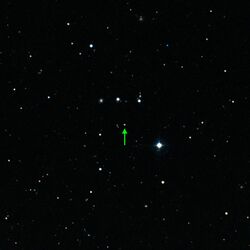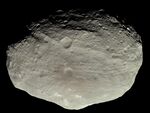Astronomy:SDSS J102915+172927
| Observation data Equinox J2000.0]] (ICRS) | |
|---|---|
| Constellation | Leo |
| Right ascension | 10h 29m 15.15s |
| Declination | +17° 29′ 28″ |
| Apparent magnitude (V) | +16.92 |
| Characteristics | |
| B−V color index | 0.03[1] |
| Astrometry | |
| Parallax (π) | 0.734±0.073[1] mas |
| Distance | 1370+150 −120[1] pc |
| Details | |
| Mass | ≤ 0.8 M☉ |
| Temperature | 5811[1] K |
| Metallicity | ≤ 6.9×10−7[1] |
| Other designations | |
2MASS J10291514+1729278 | |
| Database references | |
| SIMBAD | data |
SDSS J102915+172927 or Caffau's Star is a population II star in the galactic halo, seen in the constellation Leo. It is about 13 billion years old, making it one of the oldest stars in the Galaxy.[2] At the time of its discovery, it had the lowest metallicity of any known star.[3] It is small (less than 0.8 solar masses),[4] deficient in carbon, nitrogen, oxygen, and completely devoid of lithium. Because carbon and oxygen provide a fine structure cooling mechanism that is critical in the formation of low-mass stars, the origins of Caffau's Star are somewhat mysterious. It has been suggested, both for theoretical and observational reasons, that the formation of low-mass stars in the interstellar medium requires a critical metallicity somewhere between 1.5×10−8 and 1.5×10−6.[5] The metallicity of Caffau's Star is less than 6.9×10−7.[5] According to Schneider et al., cooling by dust rather than the fine structure lines of CII and OI may have enabled the creation of such low-mass, metal-poor stars in the early universe.[4][6] The absence of lithium implies past temperatures of at least two million kelvins.[5]
Data from Gaia's DR2 released in 2018 confirms that SDSS J102915+172927 is a dwarf star.[1]
The star was described by Elisabetta Caffau et al. in an article published by the journal Nature in September 2011. Caffau had been searching for extremely metal-poor stars for the past ten years.[7] It was identified by automated software which analyzed data from the Sloan Digital Sky Survey. This was followed up by observations with the X-shooter and UVES instruments on the Very Large Telescope in Chile.[3] Caffau and her team expect to find between five and fifty similar stars with the telescope in the future.[6]
See also
- Ultra low metallicity / ultra metal poor stars
See also
References
- ↑ 1.0 1.1 1.2 1.3 1.4 1.5 Bonifacio, P.; Caffau, E.; Spite, M.; Spite, F.; François, P.; Zaggia, S.; Arenou, F.; Haigron, R. et al. (2 May 2018). "Gaia Confirms that SDSS J102915+172927 is a Dwarf Star". Research Notes of the AAS 2 (2): 19. doi:10.3847/2515-5172/aac0f4. Bibcode: 2018RNAAS...2...19B.
- ↑ Lemonick, Michael D. (2011-09-06). "Cosmic Anomaly: The Star That Shouldn't Exist". TIME. http://www.time.com/time/health/article/0,8599,2092027,00.html.
- ↑ 3.0 3.1 "The Star That Should Not Exist". ESO. 2011-08-31. http://www.eso.org/public/news/eso1132/.
- ↑ 4.0 4.1 Schneider, Raffaella (2012-03-19). "The formation of the extremely primitive star SDSS J102915+172927 relies on dust". Monthly Notices of the Royal Astronomical Society: Letters 423 (1): L60–L64. doi:10.1111/j.1745-3933.2012.01257.x. Bibcode: 2012MNRAS.423L..60S.
- ↑ 5.0 5.1 5.2 Caffau, Elisabetta; Bonifacio, Piercarlo; François, Patrick; Sbordone, Luca et al. (1 September 2011). "An extremely primitive star in the Galactic halo". Nature 477 (7362): 67–69. doi:10.1038/nature10377. PMID 21886158. Bibcode: 2011Natur.477...67C.
- ↑ 6.0 6.1 Doyle, Amanda (2011-09-01). "A forbidden star". Astronomynow.com. http://www.astronomynow.com/news/n1109/01star/.
- ↑ Redd, Nola Taylor (2011-08-31). "Impossible Star Defies Astronomers' Theories". Space.com. http://www.space.com/12788-impossible-star-defies-theory.html.
 |





